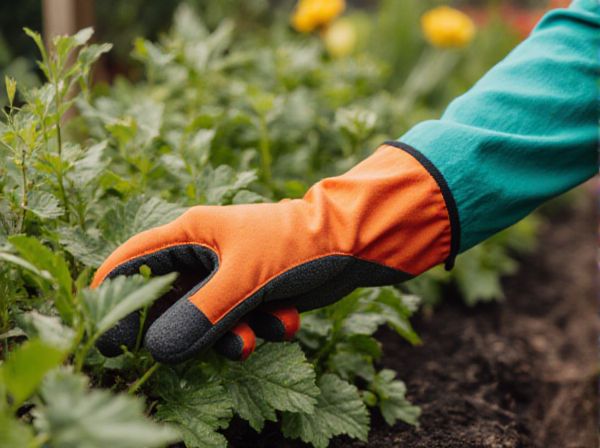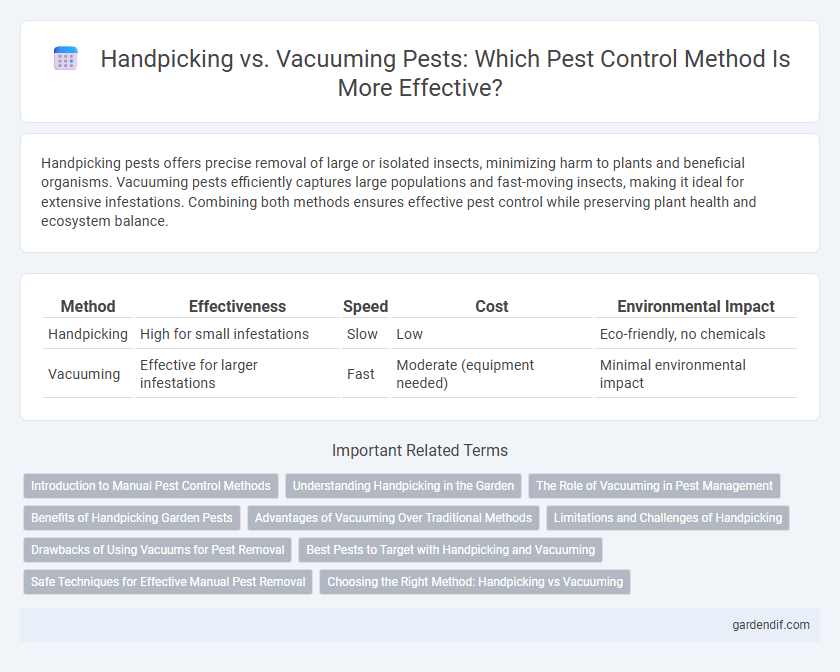
handpicking vs vacuuming pests Illustration
Handpicking pests offers precise removal of large or isolated insects, minimizing harm to plants and beneficial organisms. Vacuuming pests efficiently captures large populations and fast-moving insects, making it ideal for extensive infestations. Combining both methods ensures effective pest control while preserving plant health and ecosystem balance.
Table of Comparison
| Method | Effectiveness | Speed | Cost | Environmental Impact |
|---|---|---|---|---|
| Handpicking | High for small infestations | Slow | Low | Eco-friendly, no chemicals |
| Vacuuming | Effective for larger infestations | Fast | Moderate (equipment needed) | Minimal environmental impact |
Introduction to Manual Pest Control Methods
Manual pest control methods such as handpicking and vacuuming provide precise and eco-friendly alternatives to chemical treatments. Handpicking allows targeted removal of larger insects like beetles and caterpillars, minimizing harm to beneficial species. Vacuuming efficiently captures smaller pests including aphids and spider mites without the risk of pesticide residues on plants.
Understanding Handpicking in the Garden
Handpicking pests involves manually removing insects like beetles, caterpillars, and aphids directly from plants, which effectively prevents damage without chemical use. This method allows gardeners to target specific pests, reducing population while preserving beneficial insects and maintaining ecological balance. Handpicking is particularly effective for larger pests and in small gardens where close plant inspection is feasible.
The Role of Vacuuming in Pest Management
Vacuuming plays a critical role in pest management by efficiently removing insects, larvae, and eggs from hard-to-reach areas, reducing pest populations without the use of chemicals. Unlike handpicking, vacuuming covers larger surface areas quickly and minimizes direct contact with pests, enhancing safety for pest control operators. This method supports integrated pest management (IPM) strategies by providing a fast, effective, and environmentally friendly pest removal option.
Benefits of Handpicking Garden Pests
Handpicking garden pests offers precise control by targeting specific insects like beetles, caterpillars, and aphids, minimizing harm to beneficial insects and plants. This method reduces the reliance on chemical pesticides, promoting an eco-friendly and sustainable gardening approach. Additionally, handpicking allows immediate removal of pests, preventing damage and infestation spread in vegetable gardens and flower beds.
Advantages of Vacuuming Over Traditional Methods
Vacuuming pests offers a fast and efficient method to remove large infestations with minimal chemical use, promoting eco-friendly pest control. It captures pests precisely, reducing damage to plants and surfaces compared to handpicking which can be time-consuming and miss hidden insects. This technique also minimizes human contact with harmful pests, enhancing safety during pest management in both residential and agricultural settings.
Limitations and Challenges of Handpicking
Handpicking pests is labor-intensive and time-consuming, limiting its effectiveness in large-scale infestations or dense crop areas. It often misses hidden or fast-moving pests, reducing overall pest control efficiency. The technique also poses challenges in consistently identifying pest species and distinguishing them from beneficial insects.
Drawbacks of Using Vacuums for Pest Removal
Vacuuming pests can inadvertently spread eggs, larvae, and bacteria throughout the environment, reducing its effectiveness in complete pest eradication. The suction may also damage delicate plants or surfaces and often fails to capture pests hidden deep within crevices. Handpicking ensures targeted removal and reduces collateral damage but requires more time and effort compared to vacuum methods.
Best Pests to Target with Handpicking and Vacuuming
Handpicking is most effective for large, slow-moving pests such as caterpillars, beetles, and aphids, allowing precise removal without harming plants. Vacuuming targets small, flying insects like whiteflies, thrips, and spider mites, quickly reducing pest populations on foliage surfaces. Combining both methods enhances pest control by addressing multiple pest species and life stages efficiently.
Safe Techniques for Effective Manual Pest Removal
Handpicking pests allows precise removal of insects like aphids and caterpillars while minimizing harm to plants and beneficial insects. Vacuuming pests offers a fast, efficient method for eliminating larger infestations, particularly on indoor plants and delicate foliage. Both techniques promote chemical-free pest control, enhancing garden health through safe, targeted manual intervention.
Choosing the Right Method: Handpicking vs Vacuuming
Handpicking pests offers precise removal of larger insects like caterpillars and beetles, making it ideal for small infestations and delicate plants. Vacuuming is efficient for capturing a broad range of pests, including aphids and spider mites, especially in extensive gardens or indoor plants where manual removal is impractical. Selecting between handpicking and vacuuming depends on pest type, infestation severity, and garden size to effectively manage pest populations while minimizing plant damage.
handpicking vs vacuuming pests Infographic

 gardendif.com
gardendif.com